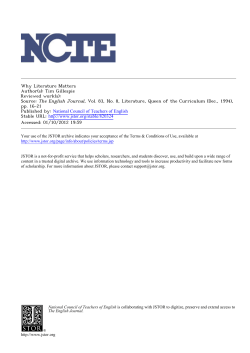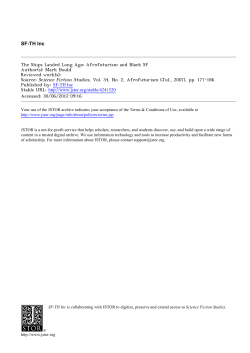
Tracing Suburban Desire
Tracing Suburban Desire Author(s): Cala Coats Source: Visual Arts Research, Vol. 40, No. 1 (Summer 2014), pp. 17-18 Published by: University of Illinois Press Stable URL: http://www.jstor.org/stable/10.5406/visuartsrese.40.1.0017 . Accessed: 12/01/2015 23:24 Your use of the JSTOR archive indicates your acceptance of the Terms & Conditions of Use, available at . http://www.jstor.org/page/info/about/policies/terms.jsp . JSTOR is a not-for-profit service that helps scholars, researchers, and students discover, use, and build upon a wide range of content in a trusted digital archive. We use information technology and tools to increase productivity and facilitate new forms of scholarship. For more information about JSTOR, please contact support@jstor.org. . University of Illinois Press is collaborating with JSTOR to digitize, preserve and extend access to Visual Arts Research. http://www.jstor.org This content downloaded from 152.3.102.242 on Mon, 12 Jan 2015 23:24:13 PM All use subject to JSTOR Terms and Conditions Visual Arts Research Tracing Suburban Desire 17 Cala Coats University of North Texas I like to walk in my neighborhood as a break from prolonged periods of writing. During today’s walk, I plucked a dandelion from the ground. I held the long stem in my hand and looked closely at the spherical network of white puffs distributed around the seed head. As with countless other dandelions, I made a wish and then blew hard, watching the seeds float away. The encounter triggered a flow of ideas about the subjective potential of the dandelion in the suburban landscape. As the puffs blew into the air, I considered how the physical strength of my breath was filled with belief in the plant’s magical ability. The act of making a wish was the performance of a child’s ideological sublime, and my wish was ultimately a fantastic nothingness to which I have assigned meaning. At that instant, though, a rupture formed. I recognized the dandelion’s ability to produce desire—the plant as desiring machine. Suddenly, I thought about the dandelion’s more common status as a weed— an intrusive assailant to the aesthetic longing of neighborhood homeowners who yearn for lush green lawns free of the uncontrolled nuisance. But what is a weed, really? Why are dandelions weeds rather than “native plants” or wildflowers? Essentially, a weed grows in a space designated for some other intended occupant— it is meddling and uninvited. The dandelion is the gypsy of suburbia. While we playfully seek their magic in the hope that a small wish may come true, they are simultaneously reviled for their jagged leaves, unremarkable flowers, and undesirable settlements. Dandelions signify yearning and destruction through a monstrous asexual existence in the suburban landscape, having the dynamic ability to manage a suburban © 2014 by the Board of Trustees of the University of Illinois VAR 40_1 text.indd 17 7/16/14 2:08 PM This content downloaded from 152.3.102.242 on Mon, 12 Jan 2015 23:24:13 PM All use subject to JSTOR Terms and Conditions 18 Visual Arts Research Summer 2014 population through productive desire. They devalue human investments by interrupting well-coiffed lawns and infesting gardens. Dandelions simultaneously generate industries for the development of chemical herbicides and hired lawn-care providers to secure against the rhizomatic spread of invading weed cells. Moreover, the dandelion’s resilient taproot poses a danger of nourishing shallower-rooting plants and breathing difference into its environment. At the same time, the entire plant is an edible, nutrient-rich, herbal remedy—an unregulated product of the supplement industry. And what about the pollinating bees that the flower attracts—where the force of a root network evolves into an unpredictable swarm? Is the plant’s strength a threat? Is its existence in this terrain ultimately constituted by the oppressive desire for its elimination, an existence that gives life to an army of profitable forces? Does the dandelion recognize its agency—its affective force that reveals the human need for social acceptance? How do dandelions continue to grow with the daily barrage of chemical and physical destruction applied to them? Still the dandelion re-emerges through tiny revolts. It materializes as an index revealing the oppressive power of capitalist suburban desire—the ordering system symbolized by the suburban lawn. The dandelion’s force of singularized potential exists within the multitude where each dandelion encounter has a meaning-producing effect. The production of its meaning is contextual, relational, and performative. The dandelion at times is plucked from the ground and blown for a wish or viewed as inspiration and transformative beauty in an education on liberatory environmental and pedagogical practices, while at other times it exists as a nuisance to be eliminated. Sadly, the meaning most frequently attributed to the dandelion is one of neglect and laziness, where the plant becomes a sign of social class and the subject of scorn. My physical encounter with the plant triggered an awareness of my material existence in relation to it. I saw my potential role as actor in my community, with neighbors, a home, and a lawn. What was I in relation to the dandelion? How had my hands affected its existence as I plucked it from the ground? What about the wish-filled breath? The dandelion acted on me as I acted on it. I hope that my wish, imbued with affirmative desire, pushed new seeds to the wind, expanding the potential of the plant. I like to imagine that they floated to unknown places, growing in unexpected ways beyond the limits of our discursive distaste for their type of flower, the boundaries of our lawns, and the physical force of our hands. VAR 40_1 text.indd 18 7/16/14 2:08 PM This content downloaded from 152.3.102.242 on Mon, 12 Jan 2015 23:24:13 PM All use subject to JSTOR Terms and Conditions
© Copyright 2025











